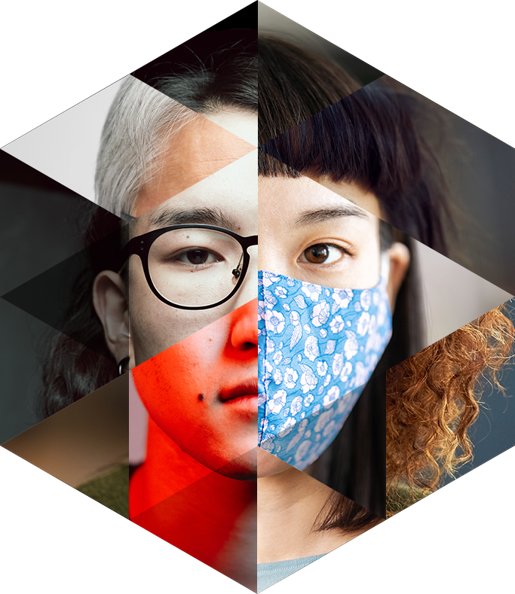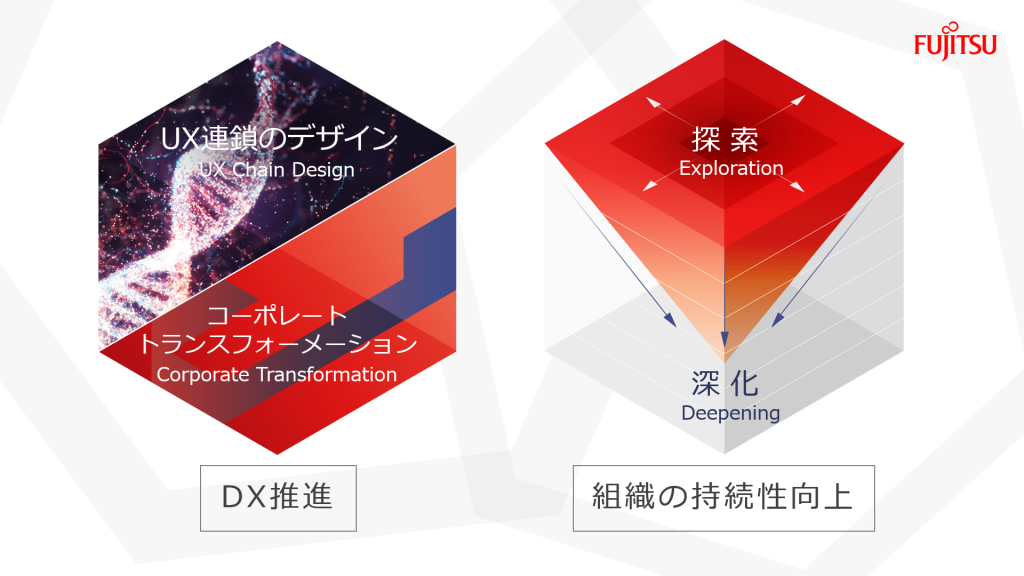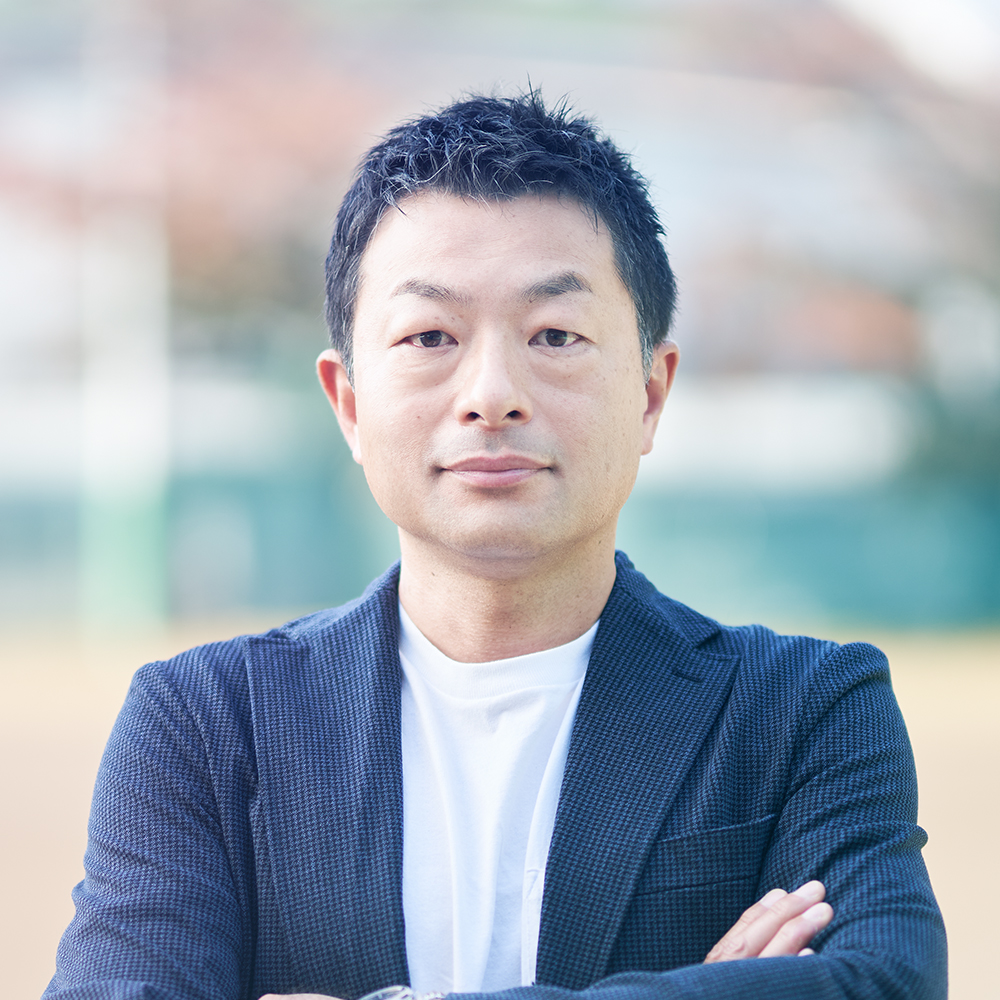- Design
- DesignThinking
- DigitalTransformation
- DX
- FujitsuDesignCenter
「富士通デザインセンター」の経営スタイル【後編】Management Style for Fujitsu Design Center: The Second Part
- Design
- DesignThinking
- DigitalTransformation
- DX
- FujitsuDesignCenter
- DesignDrivenManagement

「デザインセンター長としてのミッションと目標達成のための3か年計画」、「デザインセンターが求めるデザイナー/ノンデザイナー」、「富士通での組織ポジショニング」、「富士通のDX推進におけるデザイナーの貢献度」についてお伝えします。
※本記事は後編です。前編はこちら。
後編のポイント
・富士通における組織ポジショニング
・富士通のDX推進におけるデザイナーの貢献度
| デザイナー | 宇田 哲也 梶内 千香子 久鍋 裕美 在家 加奈子 小林 美和 須藤 有美 |
Sharing my ideas of “Mission as Head of Fujitsu Design Center and Three-Year Plan to Achieve Goals”, “Desired Designers / Non-Designers for us”,
”Our organizational position in Fujitsu” and “Designer’s Contribution to Fujitsu’s DX (Digital Transformation) Promotion”.
*This article is the second part. Click here for the first part.
Topic of the Second Part:
– Our organizational position in Fujitsu
– Designer’s Contribution to Fujitsu’s DX Promotion
| Designer | Tetsuya Uda Chikako Kajiuchi Yumi Hisanabe Kanako Ariya Miwa Kobayashi Yumi Sudo |
富士通デザインセンターの組織ポジショニング
富士通デザインセンターの業務では、新しいことを生み出すことやクリエイティブなこと、つまりイノベーションを起こす瞬発力が求められる場面もたくさんありますし、そこがビジネスの起点になることもたくさんあります。しかし、その起点が面白いだけで終わってしまう場面も過去にたくさん経験してきました。その経験から、面白いことで終わらせないためのエコシステムのデザインや、そのエコシステム上で体験されるUXの連鎖のデザインが非常に重要になってくると考えています。富士通では、尖った「個」の活動を紡いでUXの連鎖を作る取り組みを「マーケットプレース」と名付け社内で開始したところです。
社内での組織ポジショニングに関しては2021年6月1日より、デジタルソフトウエア&ソリューションビジネスグループ(通称DSSBG)から富士通本社直属の組織に変更になりました。DSSBGではソーシャルデザインやAI、データドリブンを生業とするDX推進組織と非常に近い距離感で共創を実践してきましたが、6月以降は、より幅広い組織とより密結合した共創を推進することで、富士通全社へのデザイン経営推進のミッションを推進しています。
これまでも社会の変化に先回りする形で、デザインセンターの最適な組織ポジショニングは変化してきました。現在のデザインセンターでは、事業本部との一体感と富士通全社への貢献を両立させることが大切だと考えており、事業に対する嗅覚を常に鍛えながらも、同時に自分たちのデザインセンスを飛躍的に成長させ続けていきます。

富士通のDX推進におけるデザイナーの貢献度
ノンデザイナーに対してデザイナーの貢献度を説明することは非常に難しい問題で、今も正解にたどり着けていないですし、常に自問自答し、挑戦し続けるべきイシューだと思っています。ノンデザイナーは主に売上や利益等の数字が会話の手段になりますが、デザイナーは数字ではなく感覚で感じとることが手段になることがあります。
一方、最初にお話しした通りデザインセンターのミッションは、「デザインをもっと富士通の企業活動に活用すること」、すなわちデザイン経営の推進なのですが、市場でも認知されているようにデザインの貢献度評価はそもそも数字として定量的に測定することが非常に難しかったり、全体の貢献度からデザインによる貢献の部分だけを切り取ることが難しかったりするケースも多いのが実態です。特にコーポレートリソースに対するデザイン貢献は、人や組織、プロセスや場、文化やマインドなどのコーポレートトランスフォーメーション(CX)のデザインに対して行われるので、その貢献を数字化することは様々な議論を呼ぶほど難しいものです。マインド変革に関わっているため、そもそも数字化するべきではないという声も当然あります。数字で表すために、例えばデザイン思考浸透に対する貢献度をe-learningの受講者数の増加で表そうと数字を示しても、デザインセンターを取り巻くステークホルダーの腹落ち感には欠けるということもあります。
比較的貢献度が把握しやすい新事業創生の場合であっても、B2B向けのサービスやソリューションをビジネスの主軸としている場合は、B2C向けのハードウエアのようにデザインの良さが消費者の購買の意思決定に大きな影響を与えるような手に取って感触を確かめられるモノのデザインではない場合も多いので、ビジネスでの貢献度を定量化するのが難しいのです。それはソリューションビジネスが、より複合的に様々な要素が重なり合って成立しているからであるともいえます。
そのように数字で表す難しさは前提にあるのですが、インハウスデザイン組織としてはデザインの貢献度を数値として表し、ステークホルダーに説明する責任(アカウンタビリティ)がありますので、様々な定量指標を組織のKPIとして設定し、それをトラッキングしています。種まきフェーズとしてのFY20のKPIは、立ち上げプロジェクト数や育成した人数、プロジェクトの推進スピードなど、DX推進をスタートさせることを目指した指標を設定しました。メンバーの活躍もあってFY20ではKPIにおける全ての項目を達成することができ、様々なステークホルダーからデザインセンターの貢献についてお褒めの言葉をいただきました。
このようなデザイン組織の評価手法は、昨年発表したSONY様、パナソニック様、一橋大学様との共同研究成果などでも報告されています。
ビジネス成長を意識したフェーズのFY21では、ビジネス成果に繋がるKPIを設けることで、組織としての貢献をデザイナーやノンデザイナーに伝えていきたいと思っています。デザイナーがどのくらいビジネス貢献しているかを適切に表現し、腹落ち感のある説明をすることが僕の大きなミッションのひとつでもあるので、これからも挑戦し続けたいと考えています。

編集後記(ポストスクリプト)
今回の投稿から英語併記も加え、富士通デザインセンターの活動を全世界に届けようと考えた。これはデザインやUXは一部のコアな領域に対してのみ適用されるものではなく、全ての活動に適用出来る考え方と理解しているためでもある。僕らの活動は社内に留まらず社外にも広く広がり、その存在感を発揮する前兆でもある。「デザインセンターはグローバルに活躍するチームに」。
The Design Center’s organizational position in Fujitsu
In many cases, the operations of the Design Center require “think different” and “creativity”, that is, the instantaneous momentum for innovation, and these sometimes could be the starting point of business. However, I have experienced many situations in the past where the starting point have been only interesting and moreover it hasn’t been lasted. Reflecting that experience, I think it will be very important to design an ecosystem in order not to end up with something just interesting, and to design the UX’s chain experienced on the ecosystem. At Fujitsu, we have just started our activities named “Marketplace” that we have an initiative to create a concatenated UX by connecting unique “individual” activities.
The internal organizational position of the Design Center was changed from Digital Software & Solutions Business Group (known as DSS BG) to one that reports directly to Fujitsu Headquarters from June 1st, 2021. At DSS BG, we have collaborated very closely with many DX-driving organizations such as Social-Design and Data-Driven teams, and from June 1st we are also promoting design-driven management for the full spectrum of Fujitsu collaborating with wider range of organizations.
The organizational position of the Design Center has been transformed optimally in perspective of social changes. At the current Design Center, we believe it is important both to maintain a sense of unity with individual business units and to contribute to the whole Fujitsu Group. We will continue to develop our “business sense” while at the same time growing our “design sense”.
Designer’s Contribution to Fujitsu’s DX Promotion
It is a very difficult problem to explain contributions of designers to non-designers, and we have not reached the correct answer yet, and I think it is one of our issues that we should keep asking ourselves and challenging. For non-designers, business numbers such as sales and profit are main protocol of our conversation, but for designers it is sometimes “feeling” rather than business numbers.
On the other hand, as I mentioned at the beginning, the mission of the Design Center is to apply more “design” in Fujitsu’s entire corporate activities, that is to promote design-driven management. However, as is well known in the market, there are many cases where it is very difficult to measure the degree of contribution of design quantitively or it is almost impossible to cut out only the portion of the design’s contribution from the overall contributions. In particular, because design’s contributions to corporate resources are performed to corporate transformation (CX) such as people, organizations, processes, places, cultures and mindset, it is always controversial and difficult to quantify design’s contributions. Some people naturally say that we should not evaluate them quantitively in the first place because we are involved in mind change. In order to represent our outcome quantitively, for example, to represent the degree of contribution to the penetration of design thinking by counting the number of people who received e-learning, whoever the stakeholders surrounding the Design Center may not fully agree this approach.
Even if the degree of contribution is a case of new business creation that is relatively easy to understand, it is difficult to quantify the degree of design’s contribution in a B2B business that services and solutions are business cores, because in many cases, it is not a product design that can be touched and felt such as hardware for B2C, in which good design has a significant impact on purchasing decisions for consumers. It can be said that this is because the solution business is performed by overlapping various elements in a more complex manner.
Though the difficulty of representing quantitively is a premise, as an in-house design organization we have a responsibility to represent the degree of design’s contribution quantitively and explain it to stakeholders (that is accountability), so we set various quantitative indicators as KPIs for the organization and are tracking them. As part of the seed sowing phase, the FY 20 KPIs were set out indicators aimed at starting DX promotion, including the number of projects launched, the number of people trained, and the speed at which projects were operated. Thanks to the all efforts of our designers, we were able to overachieve all of the key performance indicators for FY 20, and we received various appreciation from various stakeholders about the contributions of the Design Center.
This evaluation method of the design organization was reported in the joint research results with Sony, Panasonic and Hitotsubashi University announced last year.
In FY 21, the phase that focused on business growth, I would like to communicate designers and non-designers our organizational contributions through KPIs that lead to business results. One of my major missions is to properly represent designer’s business contribution, and to give explanations which can convince the stakeholders, so I would like to continue challenging myself.
Postscript
Written in both Japanese and English from this post, the Fujitsu Design Center aims to bring its activities to the global market. This is because we understand that design and UX are not only applicable to some core areas, but are applicable to all activities. Our activities are not confined to the company, but spread widely outside the company, and this is a sign of our presence. “The Design Center play on a global scale”.
FACEのメンバーに興味を持っていただけたでしょうか?
お仕事のご依頼や転職を検討するにあたり聞いてみたいことなど、
現場のデザイナーがお応えしますのでお気軽にご連絡ください。



